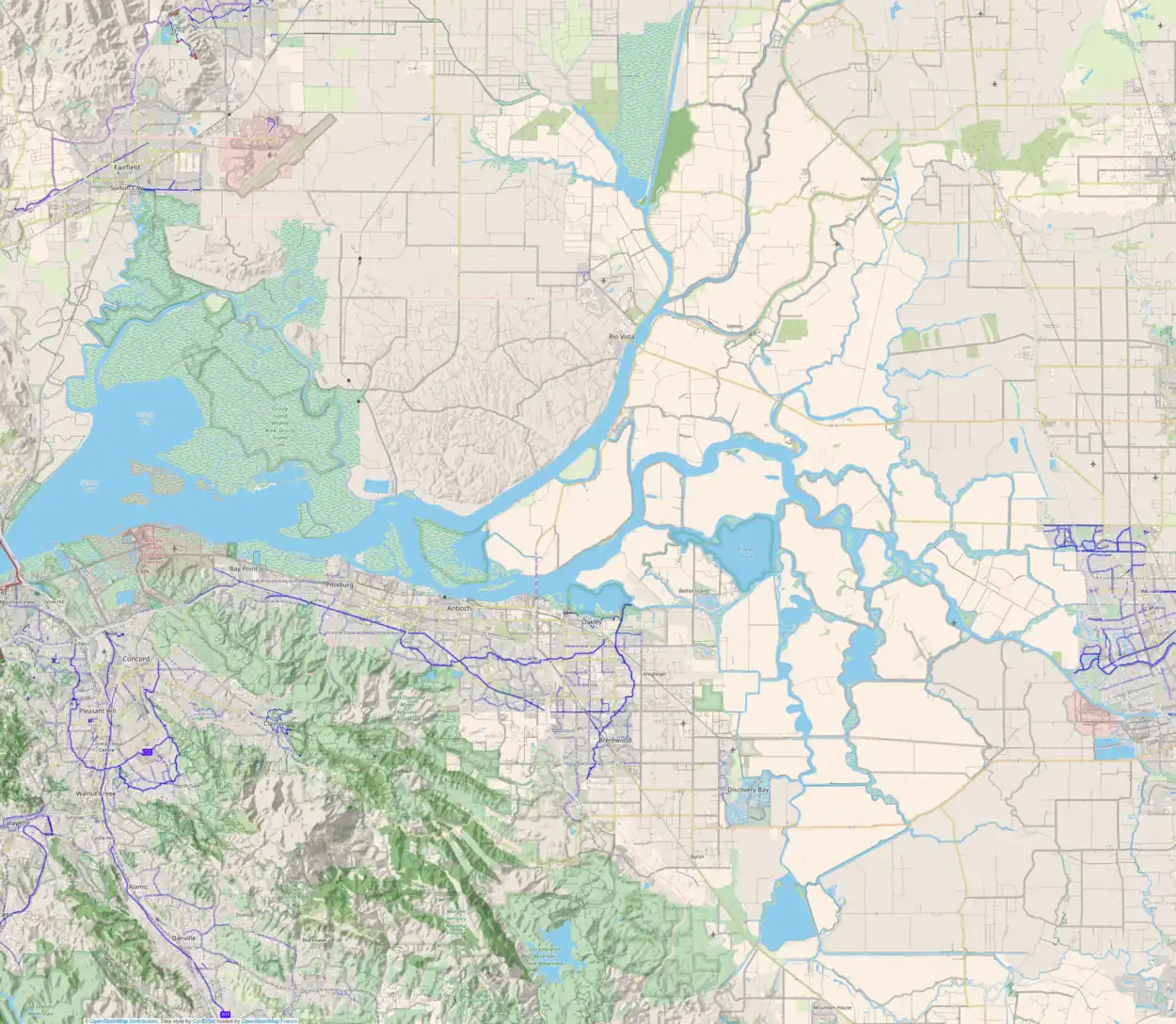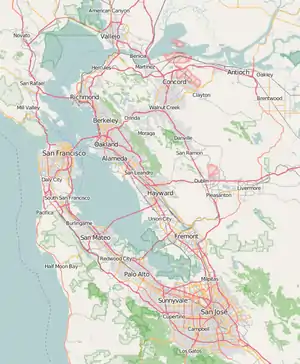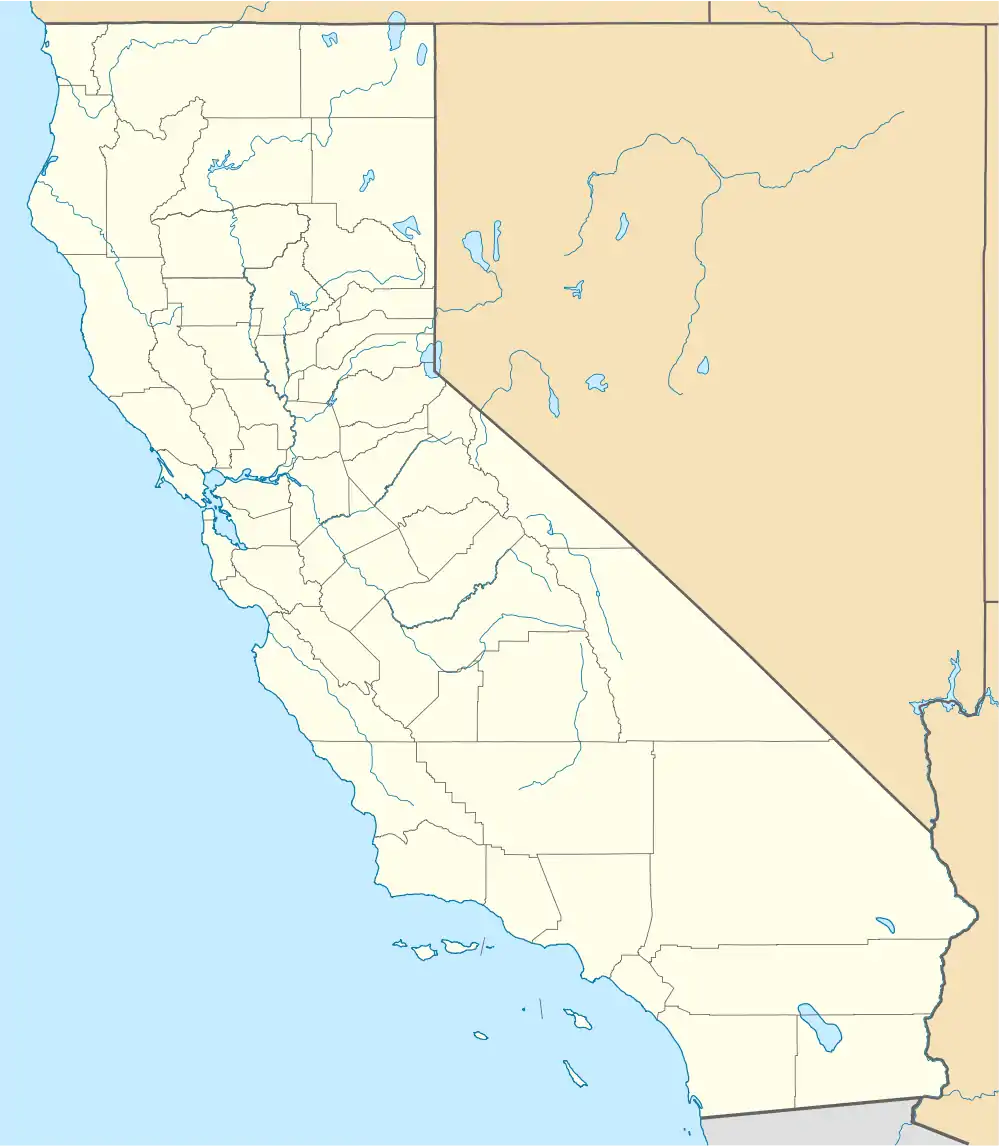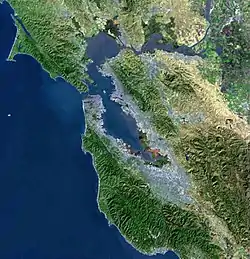 USGS aerial imagery of Joice Island, with proposed addition to reclamation district 2141 partially shaded at top. | |
 Joice Island  Joice Island  Joice Island  Joice Island | |
| Geography | |
|---|---|
| Location | Northern California |
| Coordinates | 38°09′00″N 122°03′34″W / 38.15000°N 122.05944°W[1] |
| Adjacent to | Suisun Bay |
| Administration | |
| State | |
| County | Solano |

Joice Island is a small island in Grizzly Bay (part of Suisun Bay) in California. It is part of Suisun Marsh, and has been used for hunting since the late 19th century. After a failed attempt to reclaim the land for asparagus and alfalfa farming in the early 1900s, Joice Island spent several decades as a wildlife refuge before being opened to the public for hunting in 1964. Currently, the upper portion of Joice Island is part of the California Department of Fish and Wildlife's Grizzly Island Wildlife Area; fishing, as well as the hunting of waterfowl and pigs, is permitted there on a limited basis.
Geography
Grizzly Bay, in which Joice Island is located, is part of Suisun Bay, itself a part of San Francisco Bay.[2] It is part of Solano County, and partially administered by Reclamation District 2141.[3] It is bordered on the east by Montezuma Slough, on the south by Morrow Island, on the west by Suisun Slough, and on the north by Cutoff Slough.[1] Its coordinates are 38°09′00″N 122°03′34″W / 38.15000°N 122.05944°W[1]. Joice Island is a tidal wetland, and is part of Suisun Marsh; the northern part of the island is administered as part of the Grizzly Island Wildlife Area.[4] In 2002, Joice Island was described as "a wetland area consisting of thick cattails, tules, some brush and standing water".[5][6]
History
Prior to European settlement, Joice Island was inhabited by Patwin people, whose name for the broader area - "Suisun" - means "the place of the west wind".[4]
An unlabeled island, in the same approximate location as the southernmost part of Joice Island, is shown on an 1850 survey map of the San Francisco Bay Area made by Cadwalader Ringgold[7] and also on an 1854 map of the area by Henry Lange.[8] It is first seen labeled, along with Deadman Island, Grizzly Island, Simmons Island, Ryer Island and Roe Island, on a 1902 United States Geological Survey (USGS) map of the area.[9]
In the late 19th century, Joice Island was described as "a very valuable property", known for good hunting;[10] in 1895, it was said that "the recent frosts, rain and cold weather have greatly improved the snipe grounds" on Joice Island.[11] In 1903, the island was described as a 2,700-acre (1,100 ha) tract of "rich dairy and stock land",[12] one of the largest stock ranches in central California, which had been purchased and leveed in by B. F. Rush some years prior.[12]
In 1890, one quarter of the island was owned by a mysterious (and possibly fictitious) man named Bertrand G. Chandos, allegedly the brother of a recently deceased Mrs. Bensley.[10] Of this woman, the San Francisco Examiner said "the answers to letters that were sent abroad some time ago establish beyond any doubt the fact that the stories told to various people here about her birth and early life in England and Scotland were wholly false".[10] Chandos had exchanged letters with Mrs. Bensley in which their relationship was represented inconsistently; "in nearly all of [their letters] he addresses her as 'My dear aunt,' and she writes to her 'Dear nephew.' In a few of his letters he addresses her as 'Dear madam.'"[10] It was alleged by the Examiner that Mrs. Bensley had woven a "web of intrigue" with its "primary object the defrauding of [her husband] John Bensley, and later the cheating of his creditors".[10]
By 1903, the island was owned by ex-sheriff B.F. Rush, who sold it in June to attorney Louis Titus of San Francisco for "somewhere in the neighborhood of" $10 ($326.00 in 2022) per acre.[13] The deal was described by the Sacramento Bee as "the most important real estate transaction that has taken place here for some time".[12] The same month, the Suisun Board of Trade discussed a proposal to construct a road connecting Suisun to Joice Island and nearby Grizzly Island; this road would reduce the distance between Suisun and Joice from 11 mi (18 km) to 5 mi (8.0 km).[14]
By October, Titus was "putting his grounds" in condition for a wildlife preserve, which was expected to be "one of the best preserves in the State".[15] The reserve was restricted to "the private use of himself and friends"; their first shoot was planned for October 18.[15] In November, Titus and two friends shot 63 ducks on a single hunt; several days later, he returned with his wife, and the two of them shot 35.[16] A 1905 hunt at the island's Belvedere Club, with twelve guns, shot 376 ducks.[17] However, in June 1905, the owners of Joice Island decided to use the land for agriculture, forming the Joice Island Asparagus Company. This corporation was capitalized with 1,000 shares of stock sold at $100 each, for a total of $100,000 ($3.26 million in 2022).[18] The island was planned to be reclaimed and devoted to growing asparagus and alfalfa.[18] By October, levees were being constructed by W.J. Hotchkiss and John H. Spring.[19] However, the venture was not successful; by 1908, the company's charter was forfeited.[20]: 11 By 1927, the island was home to the Mira Monte Gun Club, who in that year began construction of a new clubhouse for $20,000 ($336,935 in 2022);[21] the island was at that point well known for its large population of mallards, spoonbills and sprig.[22]
In 1932, the entire island was purchased from its then-current owner, former San Francisco police commissioner Andrew Mahonet, by the State of California for $72,000 ($1.54 million in 2022) to serve as a wildlife refuge.[23] In 1934, there was an "unusual flight of teal";[24] by 1942, the refuge had become "a resting and feeding ground for thousands and thousands of ducks and geese during the shooting season".[25] In 1947, largely due to the volume of ducks on Joice Island, hotel owners in surrounding areas (like Grizzly Island) anticipated a "heavy demand for rooms" during shooting season.[26] In 1942, a project to further develop the refuge was completed; 8 mi (13 km) of levees and four flood gates were installed to "allow better control of the refuge water supply and protect the entire area from inundation during the flood season".[25] The water-control system also helped prevent disease among waterfowl; in 1952, while many waterfowl in the region were struck with botulism, at Joice Island "the water was kept fresh and no sick ducks were seen even at the peak of population".[27][28] In 1952, the Volanti Duck Club was situated on the island,[29] and in 1958, the refuge was estimated to contain "slightly less than a half million" ducks.[30]
In 1963, a proposal was made to open the island to the general public for hunting. While a group known as the Humane Affiliates opposed the opening of the preserve on the principle that "hunting will soon be passe", the Department of Fish and Game approved the proposal;[31] in 1964, the eastern portion of the island was made available for public shooting.[32] That hunting season, there were estimated to be some 200,000 birds on Joice Island;[33] the next year, hunters on Joice Island "brought down close to three birds per man".[34] In 1966, the Grizzly Island hunting area (including Joice Island as well as Grizzly Island) had a limit of 550 shooters at a time.[35] Despite unfavorable weather conditions in 1967, there were still an estimated 393,000 ducks at Joice Island during the shooting season.[36]
Hunting continued in the following decade; in 1977, hunters at Joice Island took an average of almost three birds per shoot,[37] and in 1980 they took an average of 2.47.[38] In 1982, the island was open to hunters for only two days (which yielded an average of 3.34 birds per hunter).[39]
In 1983, duck populations on Joice Island had decreased to the point where the Department of Fish and Game closed it to hunters.[40] Joice Island was open to fishing in 1989, however,[41] and in 1992 it was the site of a pig hunt.[42]
By the 1990s, duck populations had recovered, and Joice Island was partially reopened for a "special opportunity hunt during the second half of the 1994–95 waterfowl season".[40] A maximum of 35 hunters were allowed to shoot on the island that season.[43] The island was open for hunting the next season as well (with an average of 2.51 ducks per hunter).[44] However, by 1998, the island was once again protected.[45]
More pig hunts would be held at Joice Island in 2001,[46] 2002,[5][6] 2003,[47] 2006,[48] 2012,[49] and 2017.[50]
Currently, access to Joice Island during hunting season is restricted, and hunters are "required to purchase in advance a Type A hunting pass in order to exchange for an entry permit".[4]
References
- 1 2 3 U.S. Geological Survey Geographic Names Information System: Joice Island
- ↑ California State Automobile Association (1999). San Francisco Bay Region (Map). 1:190,000. American Automobile Association.
- ↑ "Municipal Service Review: Solano County Water, Irrigation, Reclamation, and Flood Management Agencies" (PDF). Solano County LAFCO. Michael Brandman Associates. 13 April 2009. Archived (PDF) from the original on 14 March 2021. Retrieved 23 February 2021.
- 1 2 3 "Grizzly Island Wildlife Area". California Department of Fish and Wildlife.
- 1 2 "Outdoor Notes". The Napa Valley Register. Napa, California. 2002-12-12. p. 19. Retrieved 2021-11-18 – via Newspapers.com.
- 1 2 "Carl". The Napa Valley Register. Napa, California. 2002-12-12. p. 20. Retrieved 2021-11-18 – via Newspapers.com.
- ↑ Ringgold, Cadwalader; Stuart, Fred D.; Everett, Chas.; Harrison (1850). "General Chart embracing Surveys of the Farallones Entrance to the Bay of San Francisco, Bays of San Francisco and San Pablo, Straits of Carquines and Suisun Bay, and the Sacramento and San Joaquin Rivers, to the Cities of Sacramento and San Joaquin, California". David Rumsey Map Collection. San Francisco Common Council. Archived from the original on 7 July 2017. Retrieved 25 February 2021.
- ↑ Lange, Henry (1854). "Bai San Francisco und Vereinigung des Sacramento mit dem San Joaquin". David Rumsey Map Collection. George Westermann. Archived from the original on 10 March 2016. Retrieved 25 February 2021.
- ↑ Goode, R.U.; Fletcher, L.C. (1902), Topography, State of California: Woodward Island Quadrangle, United States Geological Survey
- 1 2 3 4 5 "Mrs. Bensley's Methods". The San Francisco Examiner. San Francisco, California. 1890-06-06. p. 4.
- ↑ "Duck-Shooting Improving". The San Francisco Examiner. San Francisco, California. 1895-11-09. p. 11.
- 1 2 3 "Sale of Joice Island, Solano County". The Sacramento Bee. Sacramento, California. 1903-06-04. p. 5.
- ↑ "San Francisco Lawyer Purchases an Island". Napa Journal. Napa, California. 1903-06-26. p. 3.
- ↑ "New Road From Suisun to Joice and Grizzly". The Sacramento Bee. Sacramento, California. 1903-06-08. p. 6.
- 1 2 "Sportsmen enjoy grand sport on the marshes after ducks". The San Francisco Call. San Francisco, California. 1903-10-16. p. 8.
- ↑ "Louis Titus and Friends Find Good Shooting Near Solano". The Berkeley Gazette. Berkeley, California. 1903-11-14. p. 5.
- ↑ "Local Hunters". Oakland Tribune. Oakland, California. 1905-10-16. p. 11.
- 1 2 "Will Reclaim Island and Grow Asparagus". Daily People's Cause. Red Bluff, California. 1905-06-24. p. 1.
- ↑ "Levee is being built around Joice Island". The San Francisco Call. San Francisco, California. 1906-10-08. p. 5.
- ↑ State, California Secretary of (November 18, 1909). "Certified Copy of Compiled Statement of Domestic Corporations Whose Charters Have Been Forfeited, and Foreign Corporations Whose Right to Do Business in This State Has Been Forfeited" – via Google Books.
- ↑ "Mira Monte Club Will Be Rebuilt". The Napa Valley Register. Napa, California. 1927-12-24. p. 8.
- ↑ "Wild Ducks Flocking to Game Refuge". Oroville Mercury Register. Oroville, California. 1932-06-25. p. 5.
- ↑ "Critics Claim Price Too High Paid By State". Napa Journal. Napa, California. 1932-12-09. p. 1.
- ↑ "Duck Refuge Proves Boon to Ranchmen". The Whittier News. Whittier, California. 1934-09-25. p. 5.
- 1 2 "Game Project Completed on Napa River". Napa Journal. Napa, California. 1942-08-07. p. 1.
- ↑ "Good Duck Shooting In Solano Is Expected". The Sacramento Bee. Sacramento, California. 1947-10-20. p. 23.
- ↑ "California Outdoors". Daily Independent Journal. San Rafael, California. 1952-11-25. p. 11.
- ↑ "Damage by Ducks Soon Forgotten". The Chico Enterprise-Record. Chico, California. 1952-11-25. p. 8.
- ↑ "Officers Seek Poacher Who Shot Down Gamekeeper". Oakland Tribune. Oakland, California. 1952-10-28. p. 13.
- ↑ "Out of Doors with Field & Stream". The Napa Valley Register. Napa, California. 1958-12-10. p. 17.
- ↑ "Permit Granted". The Los Angeles Times. Los Angeles, California. 1963-06-30. p. 46.
- ↑ "Part Of Joice Refuge Will Be Open To Hunting". The Sacramento Bee. Sacramento, California. 1964-02-14. p. 58.
- ↑ "Sports Afield". The San Francisco Examiner. San Francisco, California. 1964-11-03. p. 51.
- ↑ "Waterfowl Plentiful". The San Francisco Examiner. San Francisco, California. 1965-12-10. p. 63.
- ↑ "Public Duck Areas Prime". The San Francisco Examiner. San Francisco, California. 1966-10-21. p. 54. Retrieved 2021-11-18 – via Newspapers.com.
- ↑ "No Weather For Ducks". The San Francisco Examiner. San Francisco, California. 1967-11-01. p. 64. Retrieved 2021-11-18 – via Newspapers.com.
- ↑ "Outdoor Dateline: Waterfowl rewards few". The Berkeley Gazette. Berkeley, California. 1977-12-22. p. 29. Retrieved 2021-11-18 – via Newspapers.com.
- ↑ "Mid-Valley Outdoors". The Chico Enterprise-Record. Chico, California. 1980-12-26. p. 29. Retrieved 2021-11-18 – via Newspapers.com.
- ↑ "Duck bag was down". The Press Democrat. Santa Rosa, California. 1982-01-26. p. 35. Retrieved 2021-11-18 – via Newspapers.com.
- 1 2 "Audubon Society awarded grant". The Napa Valley Register. Napa, California. 1994-12-14. p. 11. Retrieved 2021-11-18 – via Newspapers.com.
- ↑ "Joice Island open for fishing on May 15". The Napa Valley Register. Napa, California. 1989-04-18. p. 9. Retrieved 2021-11-18 – via Newspapers.com.
- ↑ "Limited dates scheduled for '92 pig hunting". The Press-Tribune. Roseville, California. 1992-06-18. p. 14. Retrieved 2021-11-18 – via Newspapers.com.
- ↑ "Joice Island ponds open for hunting". The Sacramento Bee. Sacramento, California. 1994-12-15. p. 106. Retrieved 2021-11-18 – via Newspapers.com.
- ↑ "Birds: Plenty of kills statewide". Lassen County Times. Susanville, California. 1996-03-19. p. 29. Retrieved 2021-11-18 – via Newspapers.com.
- ↑ "Sights, sounds of near-perfect duck opener in the Grasslands". The San Francisco Examiner. San Francisco, California. 1998-10-14. p. 56. Retrieved 2021-11-18 – via Newspapers.com.
- ↑ "Special hunts are looming". The Press-Tribune. Roseville, California. 2001-01-03. p. 13. Retrieved 2021-11-18 – via Newspapers.com.
- ↑ "Wild pig hunts at Grizzle/Joice Islands". The Napa Valley Register. Napa, California. 2003-01-02. p. 17. Retrieved 2021-11-18 – via Newspapers.com.
- ↑ "One last thing or two". The Modesto Bee. Modesto, California. 2006-01-11. p. 28. Retrieved 2021-11-18 – via Newspapers.com.
- ↑ "Pig hunt permits offered". The Sacramento Bee. Sacramento, California. 2012-02-05. p. H3. Retrieved 2021-11-18 – via Newspapers.com.
- ↑ "Applications available for Joice Island pig hunts". Napa Valley Register. Napa, California. 2017-02-10. p. B4. Retrieved 2021-11-18 – via Newspapers.com.
